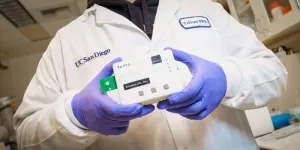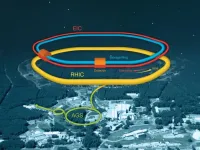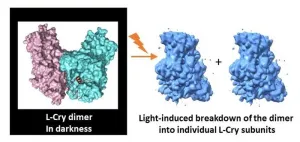(Press-News.org) A compound—one of 27 million screened in a library of potential new drugs—reversed four types of chronic pain in animal studies, according to new research led by NYU College of Dentistry’s Pain Research Center and published in the Proceedings of the National Academy of Sciences (PNAS).
The small molecule, which binds to an inner region of a calcium channel to indirectly regulate it, outperformed gabapentin without troublesome side effects, providing a promising candidate for treating pain.
Calcium channels play a central role in pain signaling, in part through the release of neurotransmitters such as glutamate and GABA— “the currency of the pain signal,” according to Rajesh Khanna, director of the NYU Pain Research Center and professor of molecular pathobiology at NYU Dentistry. The Cav2.2 (or N-type) calcium channel is the target for three clinically available drugs, including gabapentin (sold under brand names including Neurontin) and pregabalin (Lyrica), which are widely used to treat nerve pain and epilepsy.
Gabapentin mitigates pain by binding to the outside of the Cav2.2 calcium channel, affecting the channel’s activity. However, like many pain medications, gabapentin use often comes with side effects.
“Developing effective pain management with minimal side effects is crucial, but creating new therapies has been challenging,” said Khanna, the senior author of the PNAS study. “Rather than directly going after known targets for pain relief, our lab is focused on indirectly targeting proteins that are involved in pain.”
Inside the channel
Khanna has long been interested in a protein called CRMP2, a key regulator of the Cav2.2 calcium channel that binds to the channel from the inside. He and his colleagues previously discovered a peptide (a small region of amino acids) derived from CRMP2 that could uncouple CRMP2 from the calcium channel. When this peptide—dubbed the calcium channel‐binding domain 3, or CBD3—was delivered to cells, it acted as a decoy, blocking CRMP2 from binding to the inside of the calcium channel. This resulted in less calcium entering the calcium channel and less neurotransmitter release, which translated to less pain in animal studies.
Peptides are difficult to synthesize as drugs because they are short-acting and easily degrade in the stomach, so the researchers sought to create a small molecule drug based on CBD3. Starting with the 15 amino acids that make up the CBD3 peptide, they honed in on two amino acids that studies showed were responsible for inhibiting calcium influx and mitigating pain.
“At that point, we realized that these two amino acids could be the building blocks for designing a small molecule,” said Khanna.
From 27 million to one
In collaboration with colleagues at the University of Pittsburgh, the researchers ran a computer simulation that screened a library of 27 million compounds to look for a small molecule that would “match” the CBD3 amino acids.
The simulation narrowed the library down to 77 compounds, which the researchers experimentally tested to see if they lessened the amount of calcium influx. This further pared the pool down to nine compounds, which were assessed using electrophysiology to measure decreases in electrical currents through the calcium channels.
One compound, which the researchers named CBD3063, emerged as the most promising candidate for treating pain. Biochemical tests revealed that CBD3063 disrupted the interaction between the CaV2.2 calcium channel and CRMP2 protein, reduced calcium entering the channel, and lessened the release of neurotransmitters.
“Many scientists have screened the same library of compounds, but have been trying to block the calcium channel from the outside. Our target, these two amino acids from CRMP2, is on the inside of the cell, and this indirect approach may be the key to our success,” said Khanna.
Four labs, four types of pain
Khanna’s lab then tested CBD3063 with mouse models for pain related to injury. The compound was effective in alleviating pain in both male and female mice—and notably, in a head-to-head test with the drug gabapentin, the researchers needed to use far less CBD3063 (1 to 10 mg) than gabapentin (30 mg) to reduce pain.
To explore whether CBD3063 helped with different types of chronic pain, Khanna partnered with researchers at Virginia Commonwealth University, Michigan State University, and Rutgers University. Collaborators ran similar studies administering CBD3063 to treat animal models of chemotherapy-induced neuropathy, inflammatory pain, and trigeminal nerve pain—all successfully reversing pain, similar to gabapentin.
But unlike gabapentin, the use of CBD3063 did not come with side effects, including sedation, changes to cognition such as memory and learning, or changes to heart rate and breathing.
What’s next
The researchers are continuing to study CBD3063, refining its chemical composition and running additional tests to study the compound’s safety and assess if tolerance develops.
Long-term, they hope to bring a CBD3063-derived drug to clinical trials in an effort to offer new options for safe and effective pain relief.
“Identifying this first-in-class small molecule has been the culmination of more than 15 years of research. Though our research journey continues, we aspire to present a superior successor to gabapentin for the effective management of chronic pain,” said Khanna.
Additional authors include Kimberly Gomez, Tyler Nelson, Heather Allen, Aida Calderon-Rivera, Sara Hestehave, Erick Rodríguez Palma, Paz Duran, Santiago Loya-Lopez, Samantha Perez-Miller, and May Khanna of NYU Dentistry’s Pain Research Center; Elaine Zhu and Jing Wang of NYU Grossman School of Medicine; Handoko and Paramjit Arora of NYU’s Department of Chemistry; Ulises Santiago and Carlos Camacho of the University of Pittsburgh; Yuan Zhou, Angie Dorame, and Aude Chefdeville of the University of Arizona; Upasana Kumar, Rory Shields, Wanhong Zuo, Huijuan Hu, and Olga Korczeniewska of Rutgers University; Eda Koseli, Bryan McKiver, and M. Imad Damaj of Virginia Commonwealth University; Denise Giuvelis and Tamara King of the University of New England; Kufreobong Inyang and Geoffroy Laumet of Michigan State University; Dongzhi Ran, Yi Lu, and Xia Liu of Chongqing Medical University; Marcel Patek of Bright Rock Path LLC; and Aubin Moutal of St. Louis University.
The research labs are supported in part by the National Institutes of Health (NS098772, NS120663, DA042852, NS119263, GM115384, NS121776, NS121259, P30GM145497, and R01CA219637).
About NYU College of Dentistry
Founded in 1865, New York University College of Dentistry (NYU Dentistry) is the third oldest and the largest dental school in the US, educating nearly 10 percent of the nation’s dentists. NYU Dentistry has a significant global reach with a highly diverse student body. Visit dental.nyu.edu for more.
END
New compound outperforms pain drug by indirectly targeting calcium channels
Researchers identify a small molecule that inhibits four types of pain in preclinical studies
2023-11-13
ELSE PRESS RELEASES FROM THIS DATE:
This wireless, handheld, non-invasive device detects Alzheimer’s and Parkinson’s biomarkers
2023-11-13
An international team of researchers has developed a handheld, non-invasive device that can detect biomarkers for Alzheimer’s and Parkinson’s Diseases. The biosensor can also transmit the results wirelessly to a laptop or smartphone.
The team tested the device on in vitro samples from patients and showed that it is as accurate as the state of the art. Ultimately, researchers plan to test saliva and urine samples with the biosensor. The device could be modified to detect biomarkers for other conditions as well.
Researchers present their findings ...
Evolution of taste: Sharks were already able to perceive bitter substances
2023-11-13
A research team from the University of Cologne, in collaboration with colleagues from the Leibniz Institute for Food Systems Biology in Freising, has discovered a receptor for bitter taste in twelve different cartilaginous fish (sharks and rays). The receptor belongs to the so-called taste receptors type 2 (T2R), which also make humans perceive bitter and potentially toxic foods. Until now, it was assumed that such receptors only occur in bony vertebrates. The work was published under the title ‘A singular shark bitter taste receptor provides insights into the evolution of bitter taste perception’ ...
North Atlantic’s marine productivity may not be declining, according to new study of older ice cores
2023-11-13
To paraphrase Mark Twain, reports of declining phytoplankton in the North Atlantic may have been greatly exaggerated. A prominent 2019 study used ice cores in Antarctica to suggest that marine productivity in the North Atlantic had declined by 10% during the industrial era, with worrying implications that the trend might continue.
But new research led by the University of Washington shows that marine phytoplankton — on which larger organisms throughout the marine ecosystem depend — may be more stable than believed in the North Atlantic. The team’s analysis of an ice core going ...
New study shows perception of aging is linked to level of physical activity in arthritis patients
2023-11-13
People with arthritis who report more negative feelings about how they are aging tend to get less physical activity and perceive themselves as less healthy, according to a new study by researchers at Hospital for Special Surgery (HSS) and Weill Cornell Medicine. However, self-perception of good health explained the effect of negative thinking – providing an opportunity for clinicians to focus on a patient’s outlook on aging as well as their overall health.
“Physical activity is essential for older adults with arthritis, as it can help to reduce pain and stiffness, improve ...
Researchers take new AI approach to analyze tumors
2023-11-13
Researchers at Karolinska Institutet and SciLifeLab in Sweden have combined artificial intelligence (AI) techniques used in satellite imaging and community ecology to interpret large amounts of data from tumour tissue. The method, presented in the journal Nature Communications, could contribute to more personalised treatment of cancer patients.
While recent advances in tumour imaging provide a great insight into the microscopic world of tumours, the challenge is to interpret the huge amount of data generated. With hundreds of molecules being measured simultaneously in tens or hundreds of thousands of cells, it has become difficult for researchers to know what molecules and cells ...
Diverse forests hold huge carbon-storage potential, as long as we cut emissions, study shows
2023-11-13
Media kit
New research suggests that a realistic estimate of additional global forest carbon-storage potential is approximately 226 gigatonnes of carbon—enough to make a meaningful contribution to slowing climate change.
The study, published today in the journal Nature, highlights the critical importance of forest conservation, restoration and sustainable management in moving toward international climate and biodiversity targets. It involved hundreds of scientists around the world, who stress that this potential can be achieved by incentivizing community-driven efforts to promote biodiversity.
Forest ...
New discovery on how green algae count cell divisions illuminates key step needed for the evolution of multicellular life
2023-11-13
ST. LOUIS, MO, November 13, 2023 — An international research team led by James Umen, PhD, member, Donald Danforth Plant Science Center has made an unexpected discovery of a biased counting mechanism used by the single-celled green alga Chlamydomonas to control cell division. Chlamydomonas cells can grow very large and then divide multiple times in succession. The team found that the number of divisions a mother cell undertakes to restore its daughters to the correct starting size deviates from the mathematical optimum that was assumed to dictate ...
French and U.S. science agencies take first step to collaborate on electron-ion collider (EIC)
2023-11-13
PARIS, NOV. 13—Representatives from the U.S. Department of Energy’s (DOE) Office of Science and the French Alternative Energies and Atomic Energy Commission (CEA) have signed a “Statement of Interest” to launch what both agencies hope will be a significant collaboration on the Electron-Ion Collider (EIC). The EIC, being built in the U.S. at DOE’s Brookhaven National Laboratory in partnership with DOE’s Thomas Jefferson National Accelerator Facility (Jefferson Lab), will be a unique facility for exploring the building blocks of matter and the strongest force in nature. The agreement continues a long history of cooperation in scientific ...
Study finds people with inflammatory arthritis face significant psychological challenges in maintaining employment
2023-11-13
SAN DIEGO, CA, NOVEMBER 13, 2023 — Research from Hospital for Special Surgery (HSS) reveals a significant psychological impact related to inflammatory arthritis patients’ efforts to maintain employment while coping with the challenges of their illness. The study, titled “The Psychological Experience of Work for People with Inflammatory Arthritis (IA),” was presented at the American College of Rheumatology (ACR) Convergence 2023 on November 13 in San Diego.
“A large body of research indicates that people with inflammatory arthritis are at increased risk for work disability, which can profoundly affect their lives. ...
How marine bristle worms use a special protein to distinguish between sunlight and moonlight
2023-11-13
In a recent publication in Nature Communications, a joint research team of Johannes Gutenberg University Mainz (JGU), the University of Cologne, and the University of Oldenburg has presented their findings on the functioning of an atypical cryptochrome protein (Cry). These proteins are found in a variety of organisms, and they are often involved in light-controlled biological processes. The marine bristle worm Platynereis dumerilii, for example, employs a special Cry protein designated L-Cry to distinguish between sunlight and moonlight as well as between different moon phases. This is essential for the worms ...
LAST 30 PRESS RELEASES:
Tracing the quick synthesis of an industrially important catalyst
New software sheds light on cancer’s hidden genetic networks
UT Health San Antonio awarded $3 million in CPRIT grants to bolster cancer research and prevention efforts in South Texas
Third symposium spotlights global challenge of new contaminants in China’s fight against pollution
From straw to soil harmony: International team reveals how biochar supercharges carbon-smart farming
Myeloma: How AI is redrawing the map of cancer care
Manhattan E. Charurat, Ph.D., MHS invested as the Homer and Martha Gudelsky Distinguished Professor in Medicine at the University of Maryland School of Medicine
Insilico Medicine’s Pharma.AI Q4 Winter Launch Recap: Revolutionizing drug discovery with cutting-edge AI innovations, accelerating the path to pharmaceutical superintelligence
Nanoplastics have diet-dependent impacts on digestive system health
Brain neuron death occurs throughout life and increases with age, a natural human protein drug may halt neuron death in Alzheimer’s disease
SPIE and CLP announce the recipients of the 2025 Advanced Photonics Young Innovator Award
Lessons from the Caldor Fire’s Christmas Valley ‘Miracle’
Ant societies rose by trading individual protection for collective power
Research reveals how ancient viral DNA shapes early embryonic development
A molecular gatekeeper that controls protein synthesis
New ‘cloaking device’ concept to shield sensitive tech from magnetic fields
Researchers show impact of mountain building and climate change on alpine biodiversity
Study models the transition from Neanderthals to modern humans in Europe
University of Phoenix College of Doctoral Studies releases white paper on AI-driven skilling to reduce burnout and restore worker autonomy
AIs fail at the game of visual “telephone”
The levers for a sustainable food system
Potential changes in US homelessness by ending federal support for housing first programs
Vulnerability of large language models to prompt injection when providing medical advice
Researchers develop new system for high-energy-density, long-life, multi-electron transfer bromine-based flow batteries
Ending federal support for housing first programs could increase U.S. homelessness by 5% in one year, new JAMA study finds
New research uncovers molecular ‘safety switch’ shielding cancers from immune attack
Bacteria resisting viral infection can still sink carbon to ocean floor
Younger biological age may increase depression risk in older women during COVID-19
Bharat Innovates 2026 National Basecamp Showcases India’s Most Promising Deep-Tech Ventures
Here’s what determines whether your income level rises or falls
[Press-News.org] New compound outperforms pain drug by indirectly targeting calcium channelsResearchers identify a small molecule that inhibits four types of pain in preclinical studies



